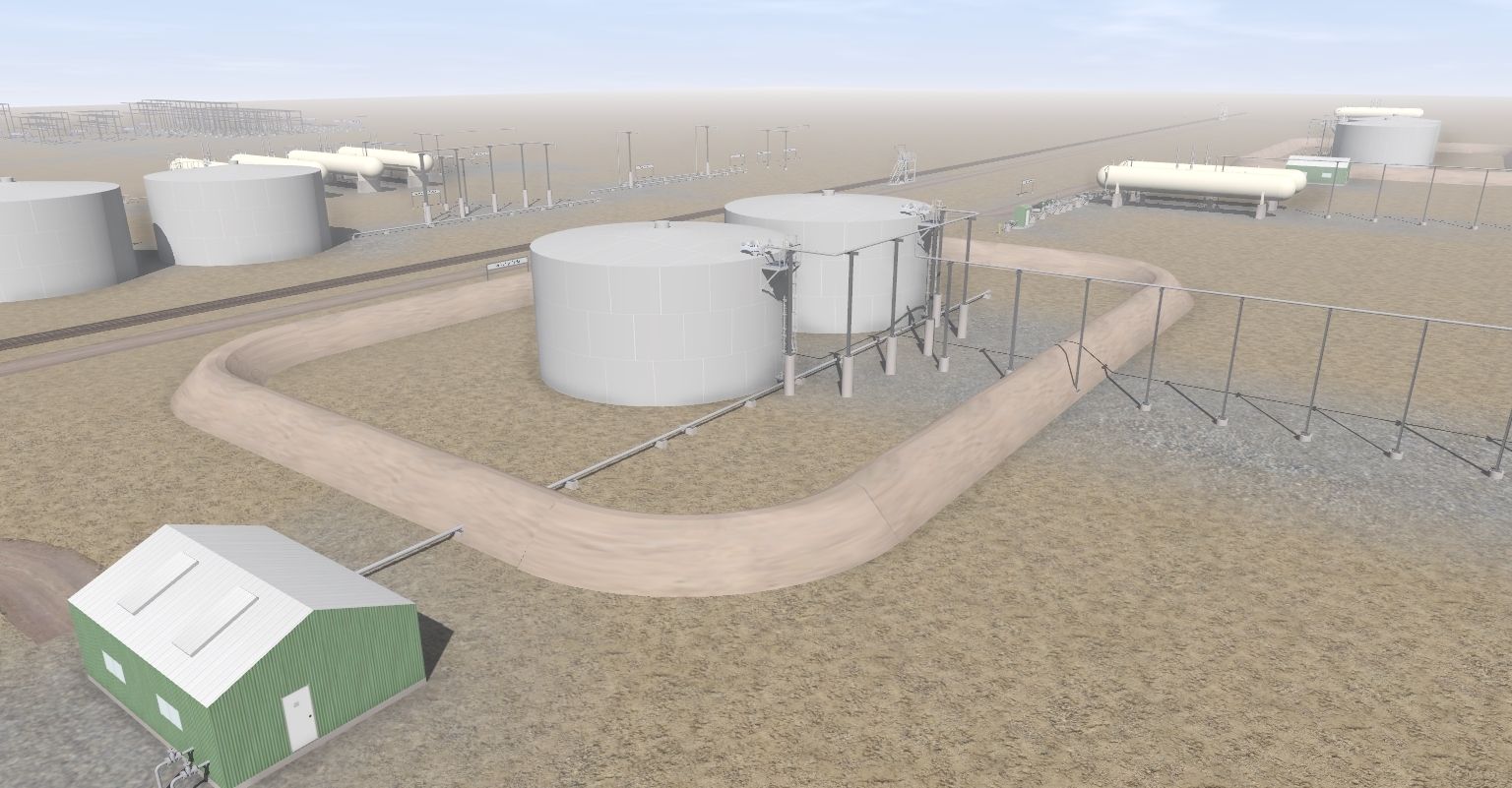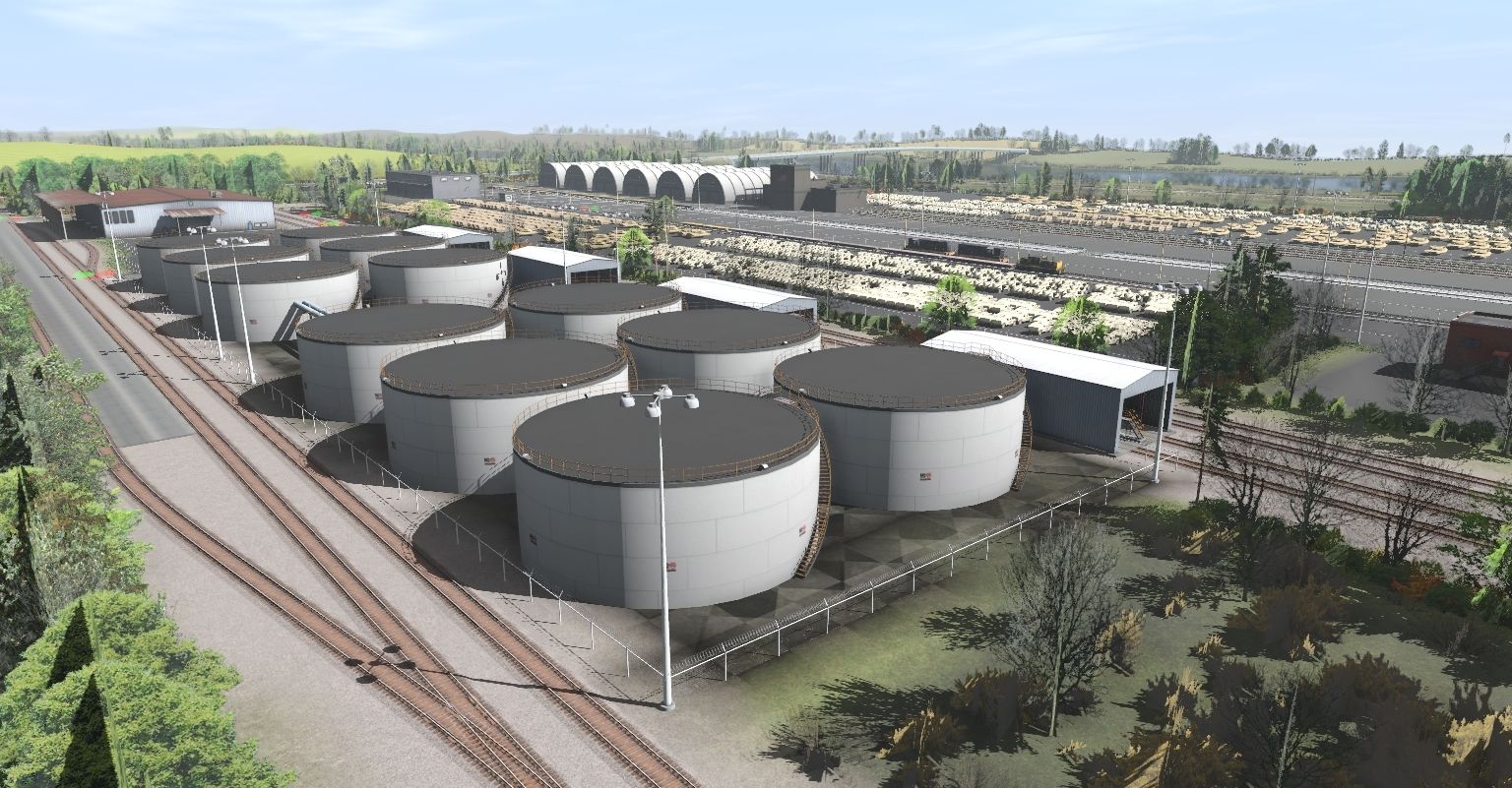DWBennett55
Member
Note that this post is about routes of the 1970's and later as secondary containment was not absolutely required before that time.
To add realism to the industrial parts of our layouts, we need to be sure and add some type of secondary containment to the storage tanks containing hazardous fluids, particularly oil. EPA SPCC regulations (https://www.epa.gov/oil-spills-prevention-and-preparedness-regulations) require a containment structure around tankage equal to 100% of the tank storage capacity plus the maximum expect amount of rainfall in a 24 hour period. This secondary containment is generally a continuous earthen berm around the tankage which, with the height of the berm and enclosed area, provides the necessary volume to contain the required volume. Small tanks can have other types of containment; concrete boxes, open top metal tanks, etc.
An example of a containment berm around storage tanks is my tank berm spline and tank berm corner objects shown in this screenshot. Each tank has a maximum storage capacity of 2402 m3 for a combine volume of 4804 m3. The berm is 2.25m high and the enclosed area (I went into Surveyor and found the dimension of the berm to be approximately 50m by 75m) of 3750 m2. The contaiment volume of the berm therefore is approximately 8437 m3 which is almost double the required volume. Therefore, the berm meets the requirements of the SPCC regulations.

My two berm assets are:
<kuid2:417385:101776:1> Oil Tank Berm corner
<kuid:417385:101833> Oil Tank Berm ver1.1
No, I don't expect everyone to do the above calculations before placing a berm around storage tanks. The calculations just illustrate how the real world works and also to note that my "looks right" berm placement in Surveyor was more than adequate for the purpose.
Not to pick on anyone (but I will) but the fuel storage farm in JR's Fort Liberty route doesn't have and secondary containment and is therefore not very realistic.

Just a guess, but I think with about half the number of tanks with a berm at the location of the surrounding fence would probably be about right for secondary containment for this tank farm.
I've seen numerous other examples of storage tanks without secondary containment in numerous routes depicting the present era. I know, picky, picky but hey, I'm engineer!
Just a thought to get our routes to be a little more real life.
Take care,
To add realism to the industrial parts of our layouts, we need to be sure and add some type of secondary containment to the storage tanks containing hazardous fluids, particularly oil. EPA SPCC regulations (https://www.epa.gov/oil-spills-prevention-and-preparedness-regulations) require a containment structure around tankage equal to 100% of the tank storage capacity plus the maximum expect amount of rainfall in a 24 hour period. This secondary containment is generally a continuous earthen berm around the tankage which, with the height of the berm and enclosed area, provides the necessary volume to contain the required volume. Small tanks can have other types of containment; concrete boxes, open top metal tanks, etc.
An example of a containment berm around storage tanks is my tank berm spline and tank berm corner objects shown in this screenshot. Each tank has a maximum storage capacity of 2402 m3 for a combine volume of 4804 m3. The berm is 2.25m high and the enclosed area (I went into Surveyor and found the dimension of the berm to be approximately 50m by 75m) of 3750 m2. The contaiment volume of the berm therefore is approximately 8437 m3 which is almost double the required volume. Therefore, the berm meets the requirements of the SPCC regulations.

My two berm assets are:
<kuid2:417385:101776:1> Oil Tank Berm corner
<kuid:417385:101833> Oil Tank Berm ver1.1
No, I don't expect everyone to do the above calculations before placing a berm around storage tanks. The calculations just illustrate how the real world works and also to note that my "looks right" berm placement in Surveyor was more than adequate for the purpose.
Not to pick on anyone (but I will) but the fuel storage farm in JR's Fort Liberty route doesn't have and secondary containment and is therefore not very realistic.

Just a guess, but I think with about half the number of tanks with a berm at the location of the surrounding fence would probably be about right for secondary containment for this tank farm.
I've seen numerous other examples of storage tanks without secondary containment in numerous routes depicting the present era. I know, picky, picky but hey, I'm engineer!
Just a thought to get our routes to be a little more real life.
Take care,

